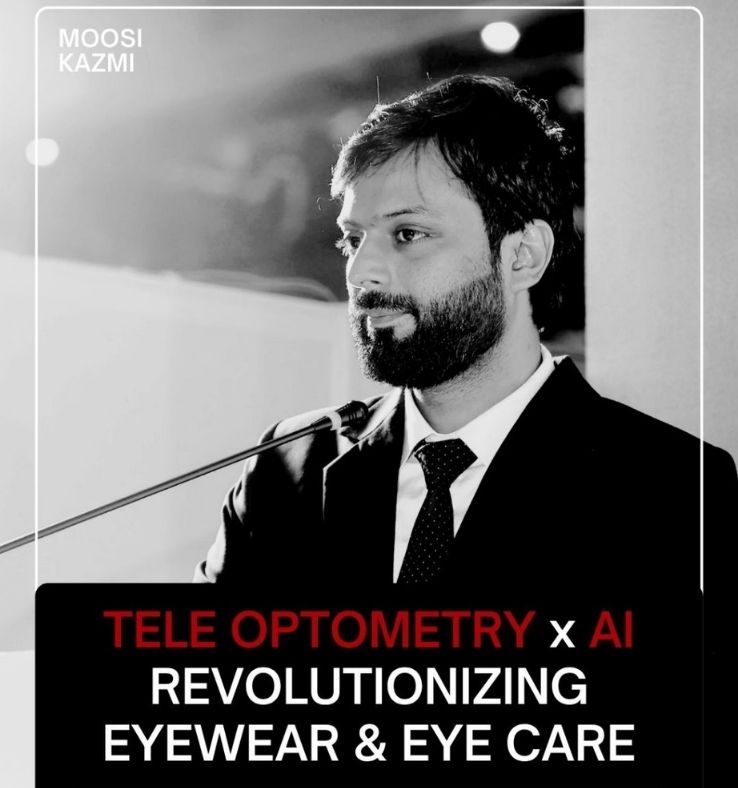"Through the Lens: Unveiling Contact Lens-Associated Microbial Keratitis"
.jpg)
Microbial keratitis (MK) linked to contact lens wear presents a significant clinical challenge due to its diverse array of causative agents and underlying factors. While bacterial infections are the most commonly associated with this condition, fungi, Acanthamoeba species, and other pathogens can contribute to its development. This complication stands as one of the gravest concerns among contact lens wearers, with the risk varying based on lens type, wearing habits, and hygiene practices.
Exploring the Etiology
The etiology of microbial keratitis is multifaceted, often stemming from factors such as overnight lens use, extended wear, poor hygiene, and inadequate cleaning solutions. These practices disrupt the cornea's natural defences, making it more susceptible to microbial invasion. Furthermore, chronic ocular surface diseases, corneal trauma, ocular surgeries, and the mechanical effects of contact lens wear contribute to the cornea's vulnerability to infection.
Navigating the Journey: Pathogenesis of Microbial Keratitis
Understanding the pathogenesis of contact lens-related microbial keratitis requires a closer look at the interplay between inherent protective mechanisms and the alterations induced by lens wear. A healthy corneal surface typically possesses robust defence mechanisms against microbial invasion. However, the wearing of contact lenses can compromise these defences, creating an environment conducive to infection. Lens wear, irrespective of oxygen transmissibility, has been found to impair epithelial mitosis, differentiation, and exfoliation, leading to a stagnant epithelium that is more prone to infection.
Hypoxia resulting from lens wear can further exacerbate this vulnerability by reducing epithelial exfoliation, although it alone does not significantly increase bacterial binding. Mechanical damage caused by contact lens wear, particularly soft lenses, can result in punctate epithelial erosions, while rigid gas-permeable lenses may cause more severe surface damage. Interestingly, reduced tear exchange beneath soft lenses can promote Pseudomonas epithelial binding, facilitating microbial colonization and biofilm formation.
Ways to differentiate: Microbial keratitis
Differential diagnosis of microbial keratitis involves careful consideration of the patient's history, clinical presentation, and risk factors. While contact lens-related bacterial keratitis is often characterized by specific clinical features, distinguishing it from other forms of keratitis, such as viral, protozoal, inflammatory, or immune-mediated, can be challenging. Microbiological testing, including bacterial and fungal cultures, is essential for confirming the diagnosis and guiding appropriate treatment strategies.
When managing microbial keratitis, medical intervention typically involves antimicrobial therapy tailored to the identified pathogen. Topical fortified antibiotics or fluoroquinolones are commonly used, with treatment intensity and frequency adjusted based on the severity of the keratitis.
Adjunctive agents such as corticosteroids, cycloplegics, and enzyme inhibitors may also be employed to mitigate inflammation and reduce the risk of visual impairment. Surgical intervention is reserved for cases refractory to medical treatment, with options including corneal patch grafts or penetrating keratoplasty to restore corneal integrity and visual function.
Corneal scarring, a common sequelae of microbial keratitis, poses significant challenges to visual rehabilitation. Depending on the location and depth of the scar, interventions such as phototherapeutic keratectomy or penetrating keratoplasty may be necessary to restore visual acuity. Preservation of healthy corneal tissue remains paramount in these procedures to optimize outcomes and minimize the risk of recurrence.
Prevention and innovations in care
Addressing the issue of contact lens care, studies reveal a high rate of noncompliance among patients, with various factors such as age, gender, smoking habits, and cleaning habits influencing healthy lens wear. Microbial keratitis risk is associated with poor hygiene, lens case contamination, and noncompliance with replacement schedules. Daily disposables show the lowest complication rates, emphasizing the importance of timely treatment to prevent scarring and vision loss. Optometrists' expanded roles could facilitate prompt care. Educating high-risk demographics, like teenagers, on proper lens use is crucial. Improvements in lens storage, case replacement, and cleaning methods could further reduce corneal ulceration rates, emphasizing the need for ongoing research to enhance lens safety and minimize risks associated with contact lens wear.
Microbial keratitis from contact lens wear demands a comprehensive approach encompassing diagnosis, prevention, and management. Collaboration among eye care specialists is essential for effectively addressing this sight-threatening condition and preserving ocular health.
References:-
1.Contact lenses 2014. Contact Lens Spectrum. 2015;30(1):22–27. [Google Scholar]
2.Dart JK, Stapleton F, Minassian D. Contact lenses and other risk factors in microbial keratitis. Lancet. 1991;338(8768):650–653. [PubMed] [Google Scholar]
3.Furlanetto RL, Andreo EG, FinottiIG, ArcieriES, Ferreira MA, Rocha FJ. Epidemiology and etiologic diagnosis of infectious keratitis in Uberlandia, Brazil. Eur J Ophthalmol. 2010;20(3):498–503. [PubMed] [Google Scholar]
4.Shah VM, Tandon R, Satpathy G, et al. Randomized clinical study for comparative evaluation of fourth-generation fluoroquinolones with the combination of fortified antibioticsin the treatment of bacterial corneal ulcers. Cornea. 2010;29(7):751–757. [PubMed] [Google Scholar]
5.Yeung K.K., Forister J.F., Forister E.F., Chung M.Y., Han S., Weissman B.A. Compliance with soft contact lens replacement schedules and associated contact lens-related ocular complications: The UCLA Contact Lens Study. Optometry. 2010;81:598–607. [PubMed] [Google Scholar]
6. Chalmers R.L., Keay L., Long B., Bergenske P., Giles T., Bullimore M.A. Risk factors for contact lens complications in US clinical practices. OptomVis Sci. 2010;87:725–735. [PubMed] [Google Scholar]

.jpg)

.jpg)
.jpg)
.jpg)


1.jpg)



.jpg)
.jpg)



_(Instagram_Post).jpg)
.jpg)
_(1080_x_1080_px).jpg)


with_UP_Cabinet_Minister_Sh_Nand_Gopal_Gupta_at_OpticsFair_demonstrating_Refraction.jpg)
with_UP_Cabinet_Minister_Sh_Nand_Gopal_Gupta_at_OpticsFair_demonstrating_Refraction_(1).jpg)

.jpg)








.jpg)



.png)




